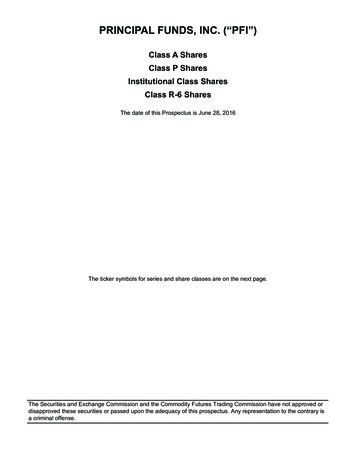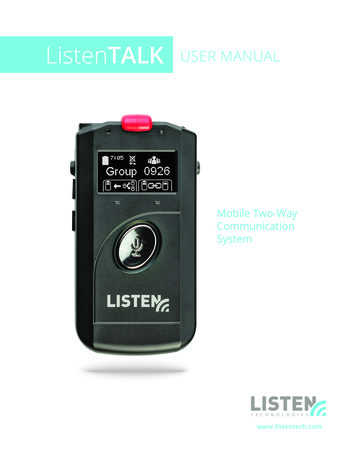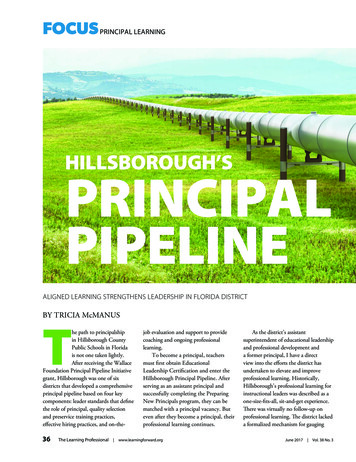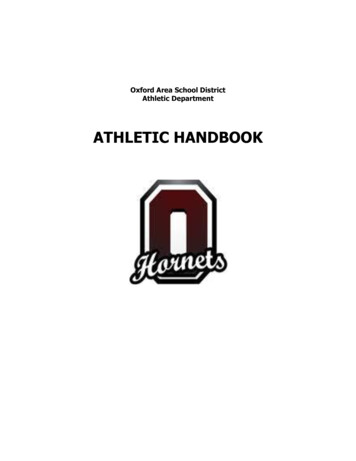
Transcription
PRINCIPAL AND SCHOOL LEADERGUIDE TO INDUCTION OF GRADUATETEACHERSDRAFT FOR CONSULTATION
Published by the Department of Education and TrainingMelbourne, January 2019 State of Victoria (Department of Education and Training) 2019The copyright in this document is owned by the Stateof Victoria (Department of Education and Training),or in the case of some materials, by third parties (third party materials).No part may be reproduced by any process except in accordance withthe provisions of the Copyright Act 1968, the National Education AccessLicence for Schools (NEALS) (see below) or with permission.An educational institution situated in Australia whichis not conducted for profit, or a body responsible for administering suchan institution may copy and communicate the materials, other than thirdparty materials, for the educational purposes of the institution.Authorised by the Department of Education and Training,2 Treasury Place, East Melbourne, Victoria, 3002.
ContentsIntroduction4Why is it important to support graduate teachers?5Induction and mentoring supports in Victoria6How to use this guide7What does effective induction look like?8Focus areas8Theory of change9Orientation10Professional Identity11Professional Practices12Wellbeing16Appendix 1 – Induction timeline and checklists for graduateteachers – Years 1 & 218Appendix 2 – Welcome pack checklist26Appendix 3 – Key resources27MORE INFORMATIONWhile this Guide is aimed at providing information for recent graduates, principalsand school leaders can also apply relevant supports to any teacher who is new toa school. Starting a job in a government school (induction): rofdev/Pages/induction.aspx Induction for New and Beginning Teachers: /teachers-induction/Pages/Home.aspx Contact: professional.practice@edumail.vic.gov.auPrincipal and School Leader Guide to Induction of Graduate Teachers 3
IntroductionDuring the first two years of teaching, graduate teachers undergo enormous growth. A consistentand thorough approach to induction supports graduate teachers to develop strong relationships withstudents and colleagues whilst building their pedagogical knowledge and experience.A well supported graduate teacher will havean immediate impact on student learning andmeaningfully contribute to all aspects of school life.Graduate teachers provide dynamism in ourteaching workforce and actively engage their recentand ongoing learning to improve student learningoutcomes. Graduate teachers are critical to thesuccess of our future generations of students.Strong and consistent school leadership is crucial tothe successful implementation of effective graduateteacher support. This Guide has been developedto assist principals and school leaders to foster themotivation, dedication and enthusiasm of graduateteachers.The Guide: provides practical implementation steps for acomprehensive induction process addresses specific areas of challenge to graduateteachers to build their skills, confidence andexperience.4 The Education StateThe companion guide to this resource: GraduateTeacher Induction Guide is designed and writtenfor graduate teachers. Used together, these twoguides can support consistent and collaborativeconversations between school leaders and graduateteachers about professional practice, professionalidentity, orientation and wellbeing.When I’m feeling happy in my teachingpractice I am positive and collaborative.I’m open to new learning and ideas. I aminspired.Graduate Teacher 2018
Teachers play a pivotal role in building the EducationState and are at the core of all workforce reform.Graduate teachers are the next generation ofcollaborative professionals.WHY IS IT IMPORTANT TO SUPPORTGRADUATE TEACHERS?From provisional to full registrationA graduate teacher is a recent graduate of an InitialTeacher Education course who is employed in aVictorian government school, and who is registeredwith the Victorian Institute of Teaching (VIT) as aprovisionally registered teacher (PRT). The VIT sets atwo-year period within which a PRT can demonstratethat they meet the requirements for full registration.Commitment to the professionGraduate teachers who participate in teacherinduction, work with mentors and are supported fromthe beginning of their careers: feel more satisfied with their job and committed tothe profession1The Education State vision for inspired graduateteachers are more effective in supporting their students tocontinuously improve learning outcomes2Graduate teachers can make a significant differenceto improving student learning outcomes. Drawing onthe evidence base and extensive stakeholder feedback,the Department of Education and Training’s (theDepartment) vision for graduate teachers is that: are committed to ongoing professionaldevelopment.Graduate teachers are inspired to collaboratewith their peers, build professional practiceexpertise, and act as professional change agentsthrough a supportive, developmentally focusedinduction into the teaching profession.Supporting excellenceA well-designed induction program may help teachersimprove student engagement and their classroommanagement skills.3 Retention of graduate teacherscan improve by as much as 85 per cent when theyhave a positive and engaging experience in inductionprocesses and are working with well trained mentors.4Classroom readinessWe also know that commencing graduate teachershave varying levels of classroom readiness and mayneed support with:Strengthening of induction and mentoring for graduateteachers was identified as an important component ofthe Excellence in Teacher Education reforms announcedby the Minister of Education in November 2016. Alongsideimproving the support for early career teachers, thereforms include measures to: raise entry standards intoinitial teacher education; support robust alternativepathways into teaching to promote diversity; and improvethe quality of initial teacher education courses. accessing school-wide curriculum plans establishing clear classroom protocols andmanaging challenging behaviour assessing and reporting student progress communicating with parents/carers cultural competencies and supporting studentpriority cohortsImproving student outcomes developing resilience in their professional practiceThe single most important thing we can do to improvestudent outcomes is to improve the quality of teachingand learning in every classroom. progressing from provisional to full registration withthe VIT.Fletcher, S. & Strong, M. (2009). Full-release and site based mentoring of elementary grade new teachers: An analysis of changes in studentachievement. New Educator, 5, 329-341.2ibid.3Everton, C. & Smithey, M. (2000). Mentoring effects on protégés classroom practice: An experimental field study. Journal of Educational Research,93(5), 294-304.4Kutsyuruba, B. (2012). Mentorship of beginning teachers: The Canadian context. In R. Yirci, and I. Kocabas (Eds.), Mentoring practices around theworld, pp. 173-200. Ankara, Turkey: Pegem Akademi.1Principal and School Leader Guide to Induction of Graduate Teachers 5
Self-efficacyINDUCTION AND MENTORINGSUPPORTS IN VICTORIABroad consultations with the education communityfound that graduate teachers: join the profession because they want to makea difference are ready to use available data, and are disposedto reflection and observation to improve practice expect challenges and support in their first yearsof teaching.Induction is not an isolated practice. School leadershave leveraged their professional networks to buildstrong, area-based collaborative induction practices.Principals and school leaders provide resources andsupports to graduates from within their schools,regions, and central program areas in the Departmentto develop a quality induction experience.In addition, several system-level components are inplace to support graduate teacher induction:My tip for new teachers is to focus onpositive attitude and effort – target yourstudents’ engagement. Graduate Teacher Conferences to support graduateteachers to build professional practice and identityand establish professional networks beyond theirown schools.Graduate Teacher 2018 The Effective Mentoring Program (EMP) to prepareteacher mentors for supporting graduate teachers’professional growth and wellbeing during the firsttwo years of employment. The Mentoring Capability Framework (MCF) forgraduate teachers, mentor teachers and schoolleadership to support and guide the mentoringrelationship. The Graduate Teacher Learning Series (LearningSeries) – an online professional learning seriesdesigned to address specific graduate needs, reflectgraduate voice and encourage development ofprofessional networks. A graduate teacher induction portal thatconsolidates resources and information forgraduate teachers. Guidance and resources that step out a bestpractice induction experience, including:Alignment with the Framework for ImprovingStudent OutcomesInduction and mentoring supports in Victoria align withtwo components of the Framework for Improving StudentOutcomes (FISO) – the Excellence in Teaching andLearning priority, and the Strategic Resource Managementdimension of the Professional Leadership priority.set goalsandisetiiorPrEo rateExplnExcellence inteachingand learningl u a tePositiveclimate forlearningStudentachievement,engagementand wellbeingParents and carersas partnersCommunityengagementin learningreploExNetworks with schools,services and d sharedleadershipVision valuesand gcommunitiesIntellectualengagement andself awarenessBuilding leadershipteamsmIm ple m e nt a n d6 The Education State»» Principal and School Leader Guide to Inductionof Graduate Teachers (this document)Global citizenshipHealth and wellbeingSetting expectationsand promoting inclusionplanE va l u a t e a n dEmpowering studentsand building school prideEvaluating impacton learningE vaEvidence-based highimpact teachingstrategiesndop avelDeailabBuilding practiceexcellenceCurriculum planningand assessmentoni tor»» Graduate Teacher Induction Guide»» Induction timeline and checklists for graduateteachers – Years 1 & 2 which sets out keyinduction tasks from the time of a graduateteacher’s recruitment through the first two yearsof teaching (see Appendix 1).
Graduate teachers are invited to work withexperienced colleagues, mentor teachers andschool leadership to:HOW TO USE THIS GUIDEThese guidelines, associated supports andresources will assist graduate teachers todevelop their professional practice and expandtheir repertoire of skills to manage the varyingresponsibilities and challenges teachersexperience within the classroom.In this Guide, principals and school leaderswill find: evidence and a rationale for a rigorous andconsistent approach to graduate teacherinduction a breakdown of the supports available toassist schools to put in place a best practiceinduction process a timeline and checklist (Appendix 1) forgraduate teachers that outlines all of the keystages and processes required to complete asuccessful induction. understand the role graduate teachers play intheir own induction understand how the school and system willsupport their induction review the timeline and checklist (Appendix 1)to help plan for induction processes and planfor opportunities to engage with school policiesand procedures explore opportunities to build networks andsupports to assist with further development.Understanding the professional developmentcontext for graduate teachers is important. Duringtheir first and second years of teaching, graduateteachers are often focused on achieving theirVIT registration. However, principals and schoolleaders play an important role in guiding graduateteachers to view their professional developmentwithin the context of a whole-school approach.Understanding their professional learning withinthe school context will assist with achieving astrong and seamless transition to the professionallearning cycle of the school once they achieve fullregistration.Principal and School Leader Guide to Induction of Graduate Teachers 7
What does effective induction look like?FOCUS AREASThe Graduate to Proficient: Australian guidelines for teacher induction into the profession (the Australian Institutefor Teaching and School Leadership (AITSL) guidelines) identifies four focus areas that are critical for effectiveinduction: Professional Practices, Professional Identity, Orientation and Wellbeing.Support in understandingexpectations of teachersin school/educationsettingProvision of supportand challenges to drivegraduate practiceimprovementOpportunities to observeand reflect on excellencein teaching and uilding skills andknowledge aboutevidence-based teachingstrategies and measuringtheir impactFocus ofinductionSupport in buildingteacher resilience,emotional wellbeing andrelationships with otherprofessionalsStrengthen individuals’capacity to managepersonal andprofessional demands ofthe roleWellbeingOrientationGuidance on technical,intellectual, ethical andcultural elements ofprofessional identityParticipation incontinuing professionalconversation throughnetworks and positiverelationships withlearners, parents andcolleaguesUnderstanding offormal policies, practice,procedural andcompliance requirementsof the school settingUnderstanding ofcultural, interpersonaland administrativerequirements andinformal expectationsof colleagues and thecommunity*Adopted from Graduate to Proficient: Australian guidelines for teacher induction into the profession (the AITSL guidelines).8 The Education State
THEORY OF CHANGETheoryof ChangeThefour focusareas are embedded within the following theory of change:If we support graduateteachers to build a strongprofessional identity throughan integrated school, regionand system-based approachthat embeds assessment ofstudent learning andcollaborative professionalpracticethen we will boostgraduate teachereffectiveness and sustaintheir commitment toimproving studentlearning outcomesthen teachers willhave strengthenedself-efficacyand more studentswill have a proficientteacher in theirclassroomso students willachieve betterlearning outcomes
Induction in PracticeOrientationWelcoming graduate teachersA formal welcome offered alongside a well-organisedorientation process sends a strong message ofinclusion and support to a graduate teacher startingtheir career. Welcoming graduate teachers to a school’scommunity ensures that teachers have access toresources and supports needed for their work. Leaderscan organise graduate teacher school orientations, putteachers in contact with their mentors, and activelymonitor graduate teachers’ journeys through induction.School orientationA coordinated orientation to the school context andthe profession is the focus of a graduate teacher’s firstterm at the school. Schools may commence graduateteacher orientation activities in the pre-commencementperiod to help graduate teachers’ transition into the firstterm. Engagement in pre-commencement inductionactivities is voluntary and graduate teachers may electto wait until their employment formally begins beforeparticipating in their school’s orientation.A school principal or a delegate will meet with agraduate teacher and take them through schoolpolicies and procedures, and introduce them to thebroader context of the school within the community.The school office will support graduate teachers asthey undertake and complete administrative tasksand acquaint themselves with the processes andregulations for everyday operation of the school.School-based induction supports graduate teachers to: perform teaching duties successfully adhere to the policies of the school ensure their own physical and mental wellbeing receive a 5 per cent reduction in scheduled dutiesover the school week during the first year ofteaching (within the resources available to theschool) to engage in professional learning access their professional practice days (one dayof release from their scheduled duties, includingteaching, per school term for full time teachers orpro rata for part time employees) work with a teacher mentor work with Professional Learning Communities10 The Education State work with Communities of Practice (if applicable)and relevant networks collect evidence of teaching to progress to full VITregistration.Principals are encouraged to invite AustralianEducation Union (AEU) representatives to explain therole of the AEU to commencing graduate teachers andprovide an opportunity to join the union available toteachers.School leaders will make sure that graduate teachersare familiar and compliant with the following policiesand procedures at the commencement of Term 1: Code of Conduct for Victorian Public SectorEmployees DET’s Values: A School Guide Protecting ChildrenInduction timeline and checklists to plan fororientationInduction timeline and checklists for graduate teachers– Years 1 & 2 (Appendix 1) sets out key induction tasksfrom the time of recruitment through the first two yearsof teaching. Links to online resources will help graduateteachers dive deeper into the areas of learning relevantto them at different points in time. The checklist willhelp graduate teachers to plan, manage and monitorinduction, with the support of their mentor teacher andschool leadership.Graduate teacher induction portalThe Department maintains an online graduateteacher induction portal. The portal is a repository ofinformation and resources covering topics such as theDepartment’s values, codes of conduct, professionalobligations, teaching practice, teacher wellbeing, andworking with families and communities.For further information cess/teachers-induction/Pages/Home.aspx
Induction in PracticeProfessional IdentityProbationary periodGraduate teachers who are employed in an ongoingposition are required to undergo a probationaryperiod not exceeding 12 months. The purpose ofthe probationary period is to ascertain whether theconduct and work performance of the teacher meetthe standards expected of employees in the teachingservice in Victorian government schools before the fullrights and responsibilities of ongoing employment areconfirmed. As part of probation, graduate teachers areprovided with support and feedback throughout theirfirst year of ongoing employment.During the probationary period the principal willmonitor the employee’s performance and provideregular feedback. The employee should be given theopportunity to discuss their performance with thedelegate.A probationary period is not required where a person isemployed fixed-term or on a casual basis.Teacher mentors work with graduate teachers toundertake professional learning, which may includepeer observation to continuously improve theirteaching, collect evidence of their work and apply forfull registration.For further information see: ll-registrationThe Graduate Teacher Learning SeriesThe Graduate Teacher Learning Series (LearningSeries) is an online professional learning seriesdesigned to address specific graduate needs, reflectgraduate voice and encourage development ofprofessional networks. The Learning Series is delivereddirect to graduate teachers in the form of an onlinemagazine. It includes monthly articles on focus topicsidentified as areas of challenge to graduate teachers,including: For further information see: /probTS.aspxusing formative assessment to improve studentlearning student engagement as a behaviour managementstrategyVIT registration teacher wellbeing and resilience.Schools will support graduate teachers to achievefull registration within the first two years of practice.The VIT specifies the requirements for moving fromprovisional to full registration on their website.5 Aftergraduation, graduate teachers register with the VITas provisionally registered teachers. To achieve fullregistration by the end of the second year of teaching,graduate teachers must provide the VIT with theevidence that they: have met the Australian Professional Standards forTeaching at the proficient teacher level using theinquiry approach, and have taught for a total of at least 80 days in one ormore Australian or New Zealand schools or earlychildhood services.5The Learning Series features views and perspectives ofgraduate teachers and is designed to deliver contentat point-of-need across the school calendar year.For further information rs/profdev/Pages/induction.aspxVictorian Institute of Teaching (VIT). Moving to full registration. ng-to-full-registrationPrincipal and School Leader Guide to Induction of Graduate Teachers 11
Induction in PracticeProfessional PracticesGraduate Teacher ConferencesProviding peer observation opportunitiesSchool principals and leaders are encouraged tosupport graduate teachers to attend a GraduateTeacher Conference in their Area during Term 3.Conferences are offered across the 17 Areas andteachers are invited to attend a conference closestto their place of work to support the development ofcollegiate relationships with fellow graduate teachersin the same Area. The conferences are designed todevelop graduate teachers’ knowledge and ability toaccess available supports, build on their professionalpractice and become strong collaborators. Graduateteachers will also be introduced to effective use ofevidence-based professional practice resources.School leaders will support graduate teachers toparticipate in peer observation early on in their careerto observe best practice across the school and gainbetter understanding of their own practice. Teachermentors will guide graduate teachers through the firstpeer observation activities.For further information see: rofdev/Pages/induction.aspxProfessional Practice DaysThe Victorian Government Schools Agreement 2017provides that each teacher is entitled to one dayper term (four days per year, pro rata for a teacheremployed part time) released from their scheduledduties, including teaching, to focus on improveddelivery of high-quality teaching and learning.The work undertaken on Professional Practice Daysmust be consistent with departmental and schoolpriorities and selected from the following areas:planning, preparation, assessment of student learning,collaboration, curriculum development, relevantprofessional development and peer observation,including feedback and reflection.School leaders may review the Induction timeline andchecklists for graduate teachers – Years 1 & 2 and theWelcome pack checklist (Appendices 1 & 2) as a usefuldocument to support discussions about the focus ofgraduate teachers’ Professional Practice Days.The purpose of peer observation is to improve teachingpractice through a structured feedback dialogueagainst a set of agreed criteria with a focus onprogressing student learning. Using an inquiry cycle,teachers can evaluate the impact of their practice onstudent learning and identify areas for improvement.The Department offers a number of resources tosupport peer observation including practical guides,tools and templates. The cycle of peer observationin the figure below provides a basis for theimplementation of peer observation, reflection andfeedback.The peer observation process follows five importantsteps:1. Teacher self-reflection: graduate teachers reflecton their practice and identify possible areas offocus to guide the upcoming peer observationactivities.2. Pre-observation conversation: graduate teachersmeet with teacher mentors to discuss the focusand the plan for conducting the upcoming peerobservations. The developmental nature of peerobservation should be discussed and agreed uponprior to commencing the peer observation activities.3. Peer observation: teachers participate in peerobservation to learn from one another, building ashared understanding of effective practice. Teachermentors support graduate teachers to:»» observe examples of best practice in the teachermentor’s and other colleagues’ classrooms»» deliver lessons that are observed by teachermentors.
4. Teacher and observer reflection: following theobservation, graduate teachers and teachermentors reflect on the observed teaching episodes,review evidence of learning and discuss bothareas of strength and areas for improvement.Teacher mentors provide constructive and specificfeedback, based on agreed criteria with a focus onprogressing student learning.For further information see: ation.aspx?&Redirect 15. Post-observation conversation: based onreflections, graduate teachers work with teachermentors to design and implement new strategies toimprove teaching and learning.Teacherself-reflectionImplementation ofnew strategies andimproved teachingand learningSelf-reflectioninforms future peerobservation ionconversationProvides anopportunity forstructured feedbackand reflection, basedon agreed criteriawith a focus onprogressing studentlearningUnderpinned bysupportive andcollaborativewhole-schoolprotocols anddevelopmentalapproachTeachers learning fromone another, building ashared understandingof effective practiceTeacherand observerreflectionPeerobservationPrincipal and School Leader Guide to Induction of Graduate Teachers 13
Induction in PracticeProfessional PracticesSupporting graduate teachers through provisionof a mentor teacherMentoring is an important formative influence ongraduate teachers’ professional practice and identity.The role of principals and school leaders is to: become familiar with the EMP, including the rolesof teacher mentors and the school in supportinggraduate teacher development and wellbeing ensure that candidates for teacher mentor roles areselected in a timely manner based on clear criteriainformed by the MCF provide release from duties and appropriatesupport to prospective teacher mentors toundertake full EMP or refresher training provide ongoing support to teacher mentors withinthe school and encourage them to access thesupports available at the system level carefully consider within the school context,individual needs of graduate teachers as well asknowledge, skills and experience of teacher mentorswhen matching mentors with mentees take into account a graduate teachers’ needsand abilities when adjusting graduate teachers’teaching load and class allocation in the first twoyears of teaching enable collaboration among all teachers withinthe school, including PLCs, and encourage teachermentors to share their knowledge and experiencewithin a wider school network to continue buildingup mentoring skills carefully monitor the mentoring process, collectingrelevant data to evaluate the success of thementoring program and adjust supports if needed establish a school-based leadership role asgraduate teacher induction and mentoringcoordinator.14 The Education StateEffective Mentoring ProgramAll teacher mentors should be trained through the EMP,which has been jointly developed by the Departmentand the VIT. This program is delivered to all Victoriangovernment schools free of charge to facilitategraduate teacher induction and maintain consistentlyhigh standards of mentoring across the system. TheEMP provides opportunities for experienced teachersto develop their mentoring skills and provide thesupport required to induct and build the professionalpractice of beginning teachers.The two-day EMP provides teachers with the mentoringskills to support graduate teachers through ongoingprofessional learning embedded in their day-to-daypractice, and therefore build the capacity of PRT as theymove to full registration. The EMP will help both mentorsand mentees to view mentoring as developmental,evidence-based and collaborative.New teachers need a like-mindedsupport network to help them throughdifficult challenges.Graduate Teacher 2018Mentoring Capability FrameworkTeacher mentor training is based on the MCF. Theframework sets out expectations and behaviours formentees, mentors and schools in the six domainsshown in the diagram on page 15.For further information see: rofdev/Pages/mentor.aspx
Supporting graduate teachers in ProfessionalLearning CommunitiesProfessional Learning Communities (PLCs) are anapproach to school improvement where groups ofteachers work collaboratively at the school level toimprove student outcomes. Schools are responsiblefor creating conditions conducive to teachers workingtogether and welcoming graduate teachers into PLCs.Building PLCs helps create a school culture that is: focused on continuous improvement by linking thelearning needs, interests and abilities of studentswith the professional learning and practice ofteachers committed to professionalism fuelled by collaborative expertise.A specific focus of PLC implementation relevant tograduate teachers is the role of PLC InstructionalLeaders. Instructional Leaders are classroom-basedspecialists who work directly with teachers to improveclassroom practice. Graduate teachers should workwith Instructional Leaders from their commencement.PLC Instructional Leaders work with other PLC schoolsin their geographic area to share effective practiceand solve common problems. Over time these networksof ‘middle leaders’ will bring together common schoolimprovement priorities.The domains of effective mentoringProfessionalCultureand ContextProfessionalGenerosityand EmpathyTeachingand sProfessionalIdentity
Induction is not an isolated practice. School leaders . strong, area-based collaborative induction practices. Principals and school leaders provide resources and supports to graduates from within their schools, regions, and central program areas in the Department to develop a quality induction experience.











